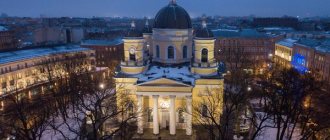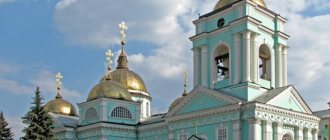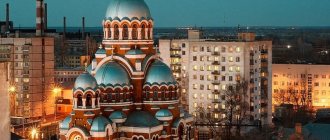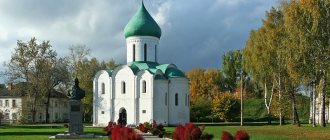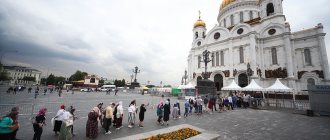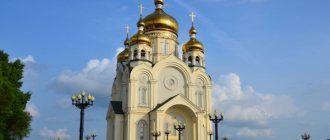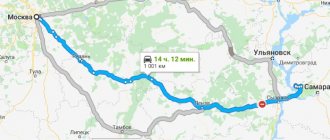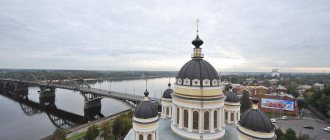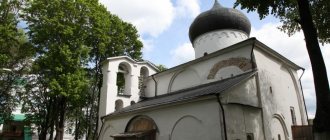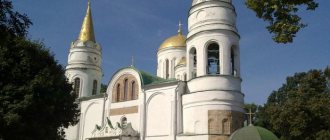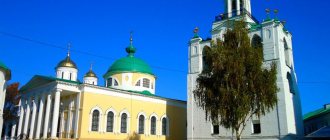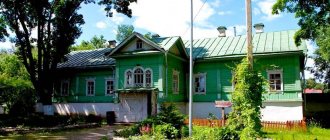"Save me, God!".
Thank you for visiting our website, before you start studying the information, please subscribe to our Orthodox community on Instagram, Lord, Save and Preserve † - https://www.instagram.com/spasi.gospodi/. The community has more than 60,000 subscribers. There are many of us like-minded people and we are growing quickly, we post prayers, sayings of saints, prayer requests, and timely post useful information about holidays and Orthodox events... Subscribe. Guardian Angel to you!
On the territory of Russia there are many spiritual architectural monuments, churches and cathedrals. This is due to the fact that people are increasingly reviving their spiritual culture every year and more and more people need to visit holy places and worship services. One of the frequently visited and revered churches is the Transfiguration Cathedral in St. Petersburg; the icons that are there work real miracles.
History of construction
In 1741, the grenadiers of the Life Guards Preobrazhensky Regiment helped the daughter of Peter I, Elizaveta Petrovna, carry out a palace coup and ascend to the Russian throne. The new empress was grateful to the loyal soldiers and officers, and therefore commissioned the architect Mikhail Zemtsov to design a regimental temple.
They decided to put the church where the regiment headquarters used to be, as they called it “moving out the hut.” It is curious that it was in this place that the future empress prayed for the return of the throne, which was illegally taken from her by Anna Leopoldovna.
In 1743, after the death of Zemtsov, construction was headed by the architect Pietro Antonio Trezzini. He changed the original design. In August 1754, shortly before the Feast of the Transfiguration, in the presence of the Empress, Archbishop Sylvester consecrated the new cathedral.
View of the Transfiguration Cathedral from Pestel Street
A baroque five-domed church with an elegant five-tiered iconostasis and a carved altar canopy appeared in St. Petersburg. It became one of the first stone churches of the city under construction. In 1796, under Emperor Paul I, the temple was awarded the honorary title of “the cathedral of the entire guard.”
In 1825, a terrible disaster occurred. A fire started in the church building. While the flames were burning, ministers and parishioners managed to remove valuable icons and liturgical utensils. The cathedral itself could not be saved. All that was left of the majestic building were the charred walls.
The upset Emperor Nicholas I ordered the restoration of the cathedral to the architect Vasily Stasov. Since little remained of the old temple, the architect prepared an original project in the Empire style, popular at that time. Construction took 4 years. In 1829, the new temple was consecrated by Metropolitan Seraphim.
General view of the Transfiguration Cathedral and Preobrazhenskaya Square
Clergy personalities associated with the cathedral
On August 6 (18), 1833, on the day of the Transfiguration of the Lord, the Montenegrin ruler and poet Peter II Petrovich Njegosh was ordained bishop in the cathedral.
Since 1881, while serving in the Preobrazhensky Regiment, the head of the cathedral was Guard Staff Captain (later Colonel) Leonid Mikhailovich Chichagov - later Metropolitan Seraphim. Being already Metropolitan of Leningrad (appointed on February 23, 1928), he performed his first service in Leningrad in the cathedral on March 18 (the third Sunday of Lent), as well as his last on October 24, 1933.
In February 1931, in the case of illegally sending the regalia of the Preobrazhensky Regiment to Copenhagen and transferring them to Empress Maria Feodorovna, along with other persons, the rector of the cathedral, Archpriest Mikhail Tikhomirov, was shot.
On April 22, 1979, during the Easter service, Metropolitan Seraphim (Nikitin), formerly of Krutitsky and Kolomna, died in the cathedral.
From July 1981 to 1985, the cleric of the cathedral was priest Evgeniy Zhdan (since 2002 - Metropolitan of Nizhny Novgorod and Arzamas).
Rectors of the cathedral
Rectors of the cathedral throughout history Dates Rector January 28, 1752 - March 13, 1758 Archpriest Luka Ivanov March 13, 1758-1781 Archpriest Andrei Mikhailov 1781 - ... Archpriest Simeon Matfiev 1793-1798 Archpriest Lukian Feodotovich Protopopov June 18, 1799-1806 Priest John Ryabinin 1806 - March 1807 Archpriest Alexander Alexandrov March 31, 1808 - January 1, 1816 Archpriest Alexy Alexievich Toropogritsky June 29, 1816 - September 6, 1829 Archpriest Antipa Gavrilovich Gavrilov January 11, 1830 - April 23, 1867 Archpriest Vasily Iakovlevich Sicilinsky May 12, 1867 - October 15, 18 82 Archpriest Mikhail Mikhailovich Spassky (1800— 1884) 1882 - March 29, 1901 [source not specified 266 days] Archpriest Pyotr Alexievich Zinovievsky April 4, 1901 - February 17, 1908 Archpriest Vladimir Feodorovich Krasnopolsky (1841-...) February 19, 1908 - July 30, 1918 Archpriest Sergiy Alekseevich Golubev (18 60—1918) 1918 - ... archpriest Pyotr Vasilyevich Troitsky (1850 - after 1917) 1921 - July 1923 archpriest Mikhail Vladimirovich Tikhomirov July 1923 - September 1924 "bishop" Evgeniy (Belkov) September 25, 1924 - November 25, 1924 "archimandrite" Ilya (Ilia Gustavovich Trolle) 1924 - January 12, 1925 “priest” Mikhail Vasilievsky January 1925 - April 1925 “priest” A. Stroganov 1932 - August 2, 1933 Archpriest Ksenophon Pavlovich Vinogradov (...-1933) August 26, 1933-1935 Archpriest Ioann Vasilyevich Morev 1935 - March 13, 193 6 Archpriest Nikolai Ioannovich Izmailov (... - around 1942) March 1936 - April 1, 1937 Archpriest Pavel Pavlovich Fruktovsky (1878-1954) April 1, 1937 - October 14, 1937 Archpriest Alexander Feodorovich Arkhangelsky October 1937-1940 Archpriest Pavel Pavlovich Fruktovsky (1878-195 4) 1940 - 19 December 1941 Protopresbyter Alexy Grigorievich Abakumov (1869-1941) December 1941 - January 1944 Archpriest Pavel Pavlovich Fruktovsky (1878-1954) January 12, 1944 - November 21, 1945 Archpriest Pavel Petrovich Tarasov (1899-1971) December 10, 1945 - March 4, 1973 Archpriest Sergius Vladimirovich Rumyantsev (1903-1977) February 21, 1973 - May 25, 1977 Archpriest Iakov Iosifovich Ilyich (1931-1981) May 25, 1977 - March 2, 1986 Archpriest Nikolai Mikhailovich Gundyaev (b. 1940) March 2, 1986 - July 1, 1987 Archpriest Pavel Grigorievich Krasnotsvetov (born 1932) June 23, 1987 - August 11, 2014 Archpriest Nikolai Mikhailovich Gundyaev (born 1940) August 11, 2014 - present Archpriest Nikolai Bryndin
History of the temple in the 19th and 20th centuries
In the 19th century, the “Guards” church was very popular in the city. Contemporaries said that St. Petersburg is famous for two churches - the Kazan and Transfiguration Cathedrals.
Since the 1870s, a charitable society was organized here. The money collected was used to maintain an almshouse for the elderly and sick, an orphanage and a canteen. There was a school for soldiers' children at the temple, and there were free apartments. Every August, a large fruit market was held on the square near the building.
After the revolution, the cathedral received the status of a parish church. All military relics of the Preobrazhensky Regiment were transferred to the Artillery Museum. During the years when the country was confiscating valuables in favor of the famine-stricken in the Volga region, many ancient icons disappeared from the cathedral without a trace.
During the Leningrad blockade, a bomb shelter was made in the basement of the church. During artillery shelling and bombing, up to 500 people hid in it. Doctors and nurses also worked here to help the wounded. During the most difficult years, services did not stop.
When the war ended, parishioners and city authorities found funds to restore the facades and interiors of the cathedral. In 1950, military banners, standards, weapons, trophies of guardsmen and Preobrazhensky uniforms of several Russian sovereigns ended up in the Hermitage storage rooms.
How did it all begin?
There is a cathedral with this name not only in the Northern capital of Russia, but also in other cities. In general, these are all the main churches that are dedicated to the Feast of the Transfiguration of the Lord.
The cathedral is currently located where there once was the northern suburb of the newly founded city of St. Petersburg. The Church of the Transfiguration of the Lord is most closely associated with Russian victories and military glory in the 18th and 19th centuries. By order of Empress Catherine I, this square was built up with barracks, where the Preobrazhensky Regiment was quartered.
Architectural features
Among the cathedrals and temples of St. Petersburg there are many architectural monuments. The Transfiguration Cathedral is no exception. The majestic temple is a striking example of the traditions of the Russian Empire style. It rises to 41.5 m, which corresponds to the height of a -14-story building.
The cathedral stands next to Liteiny Prospekt, where the Preobrazhensky barracks used to be located.
The facades of the main volume are decorated with strict four-column porticoes of the Ionic order. The massive main dome is crowned with a large light drum, and four bell towers rise around it. On the northwestern dome you can see a round tower clock.
Shrines and relics of the Transfiguration Cathedral
The main pride of the temple is the Image of the Savior Not Made by Hands and the icon of the Most Holy Theotokos “Joy of All Who Sorrow.” The first shrine, depicting a close-up of the face of Christ, was especially loved by Peter I. His mother gave it to her son, and later the icon was next to the emperor during the founding of St. Petersburg.
No less valuable for the cathedral is the image of the Mother of God of Tikhvin. It is decorated with precious stones that make it uniquely beautiful.
In the northern part of the temple you can find a warehouse donated to the church by the commander of the Preobrazhensky regiment, Konstantin Konstantinovich. It depicts the holy martyrs Constantine and Panteleimon.
The temple also keeps a memorial plaque with the names of officers of the Preobrazhensky Regiment. The list includes all deaths from 1702 to 1917.
Icon of the Most Holy Theotokos “Joy of All Who Sorrow”
Image of the Savior Not Made by Hands
Interior of the temple
Interior decoration
In an Orthodox church, three boundaries are consecrated. The main one is dedicated to the feast of the Transfiguration, revered by believers, the southern one is dedicated to Sergius of Radonezh, and the northern one is dedicated to the holy martyrs Archbishop Peter of Alexandria and Pope Clement I.
The vault of the main dome is painted to resemble the sky with clouds. There is a large star in its center. The cathedral is illuminated by natural light from semi-circular windows. In addition, under the dome hangs a huge chandelier, which can hold 120 candles.
View of the domes of the Transfiguration Cathedral
The iconostasis of the main chapel is divided into four tiers. It was made according to the sketches of Vasily Stasov. The icons were painted by famous painters Alexey Egorov, Grigory Ugryumov, Vasily Shebuev and Andrey Ivanov, who lived at the turn of the 18th-19th centuries. The painting of the cathedral's interiors was done according to Shebuev's drawings.
The carving of the pulpit, which was made by a skilled craftsman from Kostroma Vasily Zakharov, is amazing in its quality.
An ancient warehouse is kept in the cathedral. In 1900, this folding altar was presented to the temple by a member of the imperial family, Grand Duke Konstantin Konstantinovich.
The oldest icon of the cathedral is noteworthy - the image of the Savior Not Made by Hands from the 17th century. It was painted by the famous Moscow isographer Simon Ushakov for Tsar Alexei Mikhailovich. Peter I loved this image very much and took it with him everywhere.
LiveInternetLiveInternet
St. Petersburg. Preobrazhenskaya Square, 1 Years of construction: 1825-1829 Architect: Stasov V.P. In the 1730s, where the Transfiguration Cathedral is located, there was a courtyard of the grenadier company of the Preobrazhensky Regiment. This regiment was often visited by the daughter of Peter I, Elizabeth. She was the godmother of many officers' and soldiers' children and brought them gifts. On the night of November 24-25, 1741, Elizabeth arrived at the Preobrazhensk residents. After praying in front of the icon of the Mother of God, she turned to the soldiers with a request to support her in carrying out a palace coup. Elizaveta Petrovna received such support; she and the soldiers went to the Winter Palace to take over power from Anna Leopoldovna and the young Emperor Ivan VI. Cathedral of the Transfiguration of the Lord of the entire guard. Just a few days after ascending the throne, in memory of these events, the new empress decided to build a cathedral in the name of the Transfiguration of the Lord. The location for it was the yard of the Preobrazhensky Regiment. It was founded in 1743, and on August 5, 1745, the Transfiguration Cathedral was consecrated in the presence of the Empress. The authors of the project of this building were P. A. Trezzini and M. G. Zemtsov. F. B. Rastrelli took part in the creation of the interior decoration. The Transfiguration Cathedral was the last work of Mikhail Zemtsov, who died a few months after the foundation of the temple. Dome of the Transfiguration Cathedral The appearance of the first building of the Transfiguration Cathedral is now unknown, all drawings and drawings have been lost. It is known that this temple was the first with five domes. By order of Elizabeth Petrovna, the tradition of building five-domed churches was revived, whereas before her, under Peter I, churches were built according to the European single-domed system. Main gate Medals on the wings of the main gate The central decorative element of the main gate. Cross on the central gate of the Transfiguration Cathedral. The double-headed eagle on the gun barrel of the Transfiguration Cathedral was often visited by Elizaveta Petrovna. On November 12, 1796, Paul I appointed it as the temple of the entire guard. Chapel in the fence of the cathedral Element of the fence On August 8, 1825, the cathedral burned down, but during the fire they managed to remove all the shrines from it. Alexander I decided to restore the building as quickly as possible, which began in 1827. By the winter of 1827, according to the design of V.P. Stasov, the temple was restored. On August 5, 1829, a new consecration of the cathedral took place, the main altar of which was consecrated in honor of the Feast of the Transfiguration of the Lord. In 1854, chimes, brought to St. Petersburg from England, were installed on one of the cathedral towers. It is in this form that the Transfiguration Cathedral has survived to this day. Bell tower with a clock Western portico Capital of one of the columns Door of the central entrance to the Transfiguration Cathedral. Angels above the door of the Transfiguration Cathedral. Panel with military attributes. Decorative element on the walls of the Transfiguration Cathedral. The bas-relief of the New Transfiguration Cathedral has become one of the most popular in St. Petersburg. Stasov's contemporaries said that there were two outstanding buildings in the city - the Kazan and Spaso-Preobrazhensky Cathedrals. For the creation of this temple, the emperor presented the architect with a diamond ring and 1,325 rubles, saved by the architect on the construction of a fence from cannon barrels. Saint-Petersbourg — Transfiguration The restored temple was consecrated by Metropolitan Seraphim on August 5 (17), 1829. The main altar was consecrated in honor of the feast of the Transfiguration of the Lord, the right (south) chapel - in honor of St. Sergius of Radonezh, and the left (north) - in honor of the holy martyrs Clement of Rome and Peter of Alexandria, whose memorial day is celebrated on November 25 (old style). Since 1871, a parish charitable society operated at the cathedral, which maintained an almshouse, an orphanage, a canteen, a school for soldiers’ children and free apartments. Since 1912, the Brotherhood of Temperance and Chastity operated there. On the Feast of the Transfiguration of the Lord (popular name - Apple Spas), which falls on August 6 (old style), a traditional fruit market was held near the temple. St Petersbourg - Transfiguration.Gravure du XIXe siècle représentant le marché aux pommes qui se tenait le 6 août. Around the cathedral, according to Stasov’s design, a square was laid out, surrounded by an elegant fence. It consists of 34 granite bases on which 102 bronze gun barrels are placed, 3 on each. These guns were taken in the Russian-Turkish war of 1828-1829. from the walls of Turkish fortresses. All middle trunks are decorated with golden double-headed eagles with crowns. Around the cathedral there were 12 guns and 2 unicorns, which were the property of the regiment. Icon on the back wall of the Transfiguration Cathedral. Window in the Transfiguration Cathedral. Since the temple was the cathedral of the entire guard, numerous banners and other trophies obtained in the war with the Ottoman Empire were kept inside it. The Preobrazhensky uniforms of Alexander I, Nicholas I and Alexander II were kept in special cabinets, as well as the saber of Alexander II, which he was wearing on March 1, 1881 when he was mortally wounded in an assassination attempt. The cathedral was the main military temple of St. Petersburg. The area around the temple bears the name associated with it - Preobrazhenskaya Square. Since the temple was military, its clergy were subordinate to the protopresbyter of the military and naval clergy. The farm was managed by a ktitor, who was appointed by the regiment commander from among the honored officers. In 1918, the Transfiguration Cathedral became a parish church. War trophies were transferred to the Artillery Museum. In 1950 they were transferred to the State Hermitage. Most of the icons and shrines were removed from the temple in the 1920s. Although the cathedral itself was never closed, most of the temple's shrines and valuable icons were confiscated in the 20s. The general interior of the cathedral retains the appearance it had during the time of Stasov. The main dome is painted to match the color of the cloudy sky, with a large star depicted in the center. In the space under the dome there is a large five-domed chandelier with 120 candles. The iconostasis of the central aisle is four-tiered, decorated with gilded carvings on a white background. The images of the iconostasis were painted on canvas by famous painters A.I. Ugryumov, V.K. Shebuev, A.I. Ivanov. The main shrines of the Transfiguration Cathedral today are the Image of the Savior Not Made by Hands and the icon of the Mother of God “Joy of All Who Sorrow.” The image of the Savior Not Made by Hands is on the analogue near the right choir. It is closely connected with the life of Emperor Peter the Great and was his favorite image. Painted by the famous Moscow painter Simon Ushakov for Tsar Alexei Mikhailovich, the image passed to Peter I from his mother. He was with him both at the foundation of St. Petersburg and at the Poltava battle. Later it was placed in the house of Peter I on the Petersburg side, in the dining room turned into a chapel. When the chapel was closed in 1930, the venerated image was moved to the Trinity Church on Stremyannaya Street, and in 1938 - to the Transfiguration Cathedral. The revered icon of the Mother of God “Joy of All Who Sorrow” lies on the lectern near the left choir. This copy is from the miraculous icon from the Church of the Transfiguration of the Lord on Ordynka, made at the behest of Peter I’s sister, Princess Natalya Alekseevna, and brought by her from Moscow to St. Petersburg in 1711. During the war with the Turks, this image was in the ranks of the Russian army. Upon the Sovereign’s return to the capital, in memory of the salvation of him and his army during the Prut campaign of 1711, he built the Church of the Resurrection of Christ at the palace of Princess Natalia Alekseevna, where the revered image was placed. Later, a new temple for this icon was built on the site of this palace. The image remained in this church on Shpalernaya Street until its closure in 1932, when the icon was moved to the Transfiguration Cathedral. There are three altars in the temple - the main one, in the name of the Transfiguration of the Lord, the northern one, in the name of the Hieromartyr Clement, Pope of Rome and Peter the Archbishop of Alexandria, and the southern one, in the name of St. Sergius of Radonezh the Wonderworker. Near the northern wall of the cathedral, in the chapel of Saints Clement and Peter, there is a fold with images of the Transfiguration of the Lord in the center, the Great Martyr Panteleimon and the Holy King Constantine. In 1900, this folding was presented to the regimental hospital by the then commander of the regiment, Major General Grand Duke Konstantin Konstantinovich (the famous poet “K.R.”). "Transfiguration Cathedral". Unknown artist. 2nd half 19th century Spaso-Preobrazhensky Cathedral of All Guards. Photo from the 1900s. Inside the temple there is a board with a list of fallen officers of the regiment from 1702 to 1917. The Transfiguration Cathedral is one of the most visited churches in St. Petersburg. The cathedral choir is widely known, where the soloists of the Academic Chapel perform. The Transfiguration Cathedral is open daily from 8.00 to 20.00. here ***
Memorial fence
In 1828-1829, Russia and the Ottoman Empire fought with each other. After the war, the Peace of Adrianople was concluded. Russia received most of the eastern coast of the Black Sea and the Danube River delta. 10 thousand Russian soldiers died in bloody battles. Another 5 thousand died from wounds, and 110 thousand died from disease during the marches.
Main entrance to the Transfiguration Cathedral
In memory of this war, an unusual fence was built around the cathedral from captured cannons obtained in the battles for the fortresses of Izmail, Tulcha, Varna, Silistria and Isakchi. By decree of the Russian Tsar Nicholas I, the Guards Cathedral was presented with 18-pound and 24-pound guns.
On the cast iron barrels you can see the Ottoman coat of arms and the names that the Ottomans gave to the cannons: “Sacred Crescent”, “Wrath of Allah”, “I give only death” and “Spewing Thunder”. There is nothing surprising in the fact that the guns were named. The names of the guns were also cast in Russia. The famous cannon maker Andrei Chokhov made the “Wolf”, “Skoropea” and “Lion” squeaks.
The temple fence has 34 granite bases, each of which has three cannons. The guns are placed with their muzzles facing the ground. This means that they will never participate in war again.
On the main gate you can see enlarged copies of the commemorative medal. On one side there is a laurel wreath and the inscription “For the Turkish War”, and on the other there is a cross over a defeated crescent and the years “1828-1829” are indicated. The same gilded cross adorns the top of the gate.
Main gate with copies of commemorative medals on the doors
The middle cannons on the pedestals are completed with gilded coats of arms of Russia - double-headed eagles. Massive cast iron chains are stretched between the granite bases and the tools. After the revolution, the cross on the central gate and the eagles were removed, but in 2004 the memorial fence was restored to its original appearance.
Architect, exterior decoration, architectural ensemble
The architecture and composition of the building corresponds to late classicism, but Stasov honored the foundations of the original national architecture, the Kremlin Assumption Cathedral served as a model for him. Therefore, the building has a cylindrical upper part, topped with an onion-shaped vault.
The cross rushed 8 meters into the air. 4 smaller domes (of four evangelists) are displayed in the corners, everything is solemn, strict and laconic. The temple building looks majestic, its height is 41.5 meters. On the western side of the cathedral there is a 12-meter portico with 4 majestic columns, here is the main entrance. Outside you can see military attributes in the design.
To save gilding, Stasov invented an unusual mixture of paints that shimmered with the shine of blued metal. This unique recipe from Stasov turned out to be lost. The Transfiguration Cathedral in St. Petersburg is painted in light yellow tones with white accents of magnificent bas-relief work.
On one of the walls of the cathedral there is an icon with a burning lamp - this is the icon of the Transfiguration of the Lord.
The fence, built according to his own design, in memory of the victories of the Russians over the Turks, is unique in its design and construction. It consists of barrels from recovered enemy cannons, which were taken from defeated fortresses. Arranged in groups, on each central of the three there is a double-headed gilded eagle, the gun barrels are all bound with heavy chains, and they are placed with their muzzles down.
These guns with Ottoman symbols will no longer fire. The Emperor presented Stasov with a diamond ring and an award for saving money when creating an unusual fence. In 1886, a small chapel with stained glass windows was added to this environment of the cathedral, in the same style as the temple.
The planned ensemble and design of the temple square evokes true delight. With the new lighting of the cathedral, in the evening light the sparkling gilded decorations of the main gates look elegant and majestic.
Useful information for pilgrims and tourists
The ancient cathedral has been beautifully restored. In recent years, its facades and bells have been updated. In the evenings the building is beautifully illuminated, and on holidays the park around it is brightly illuminated. Tourists and believers note that inside the temple it feels like home.
There is a Sunday school at the cathedral, where children aged 5-15 years and adults study. There is a youth club and a group for studying the Holy Scriptures. The temple's social service helps the homeless and needy.
Cathedral interiors
The doors of the cathedral are open to everyone from morning to evening. Church services are held every day at 10:00 and 18:00. On Wednesdays, Fridays and Sundays there is an additional early liturgy - at 7:00. Many come here specifically to listen to the harmonious singing of the church choir.
